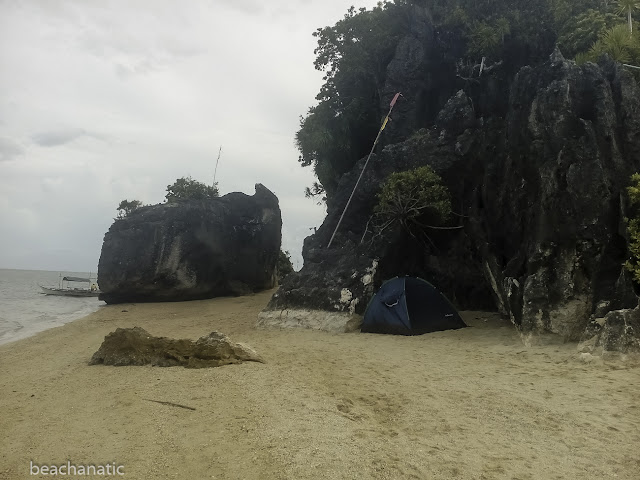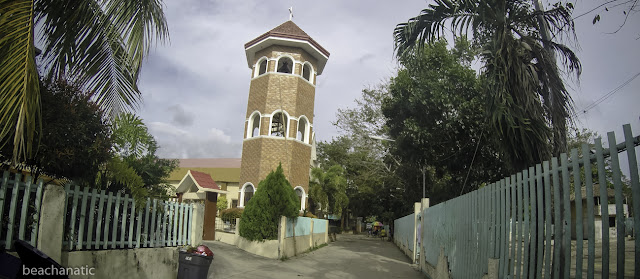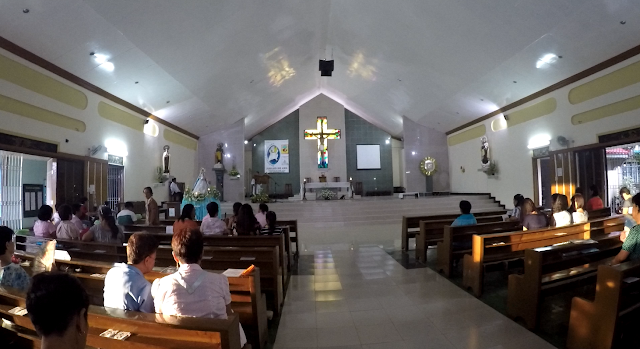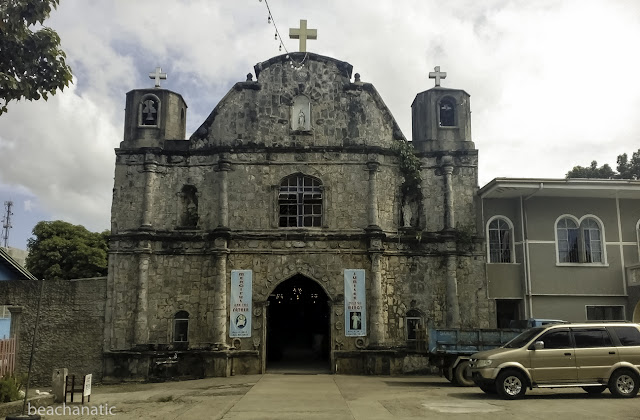Had a four-day long weekend for the All Souls Day
celebration and it became an opportuned time for another road trip. Had wanted to
explore the towns of Bataan, however the province just got hit recently by a
storm and there was flooding in some towns. So I thought of going down south.
Looking at the map, I noticed that there was this part of Quezon province which I haven’t
explored before: the Bondoc Peninsula. So I started reading articles and blogs
featuring this peninsula and found out there were some good beaches and a few
old churches in the area.
The
Bondoc Peninsula which is on the southeastern part of the province of Quezon is bordered
by water on its three sides. To the east is Ragay Gulf, to its south is Sibuyan
Sea and to its west is Tayabas Bay. It consists of twelve towns and composes
the third congressional district of the Quezon province. Starting from the northwest part of
the Peninsula then rounding to the south towards the east the towns are: Padre
Burgos , Agdangan, Unisan, Pitogo, Macalelon, General Luna, Catanauan, Mulanay,
San Francisco, San Andres, San Narciso And Buenavista.
Ecclesiastically, the
Peninsula belongs to two dioceses: The first three towns of Padre Burgos,
Agdangan and Unisan belong to the diocese of Lucena while the rest belong to
the Diocese of Gumaca.
In
order to beat the weekend traffic of people going to the provinces for the All
Souls Day, we left early from Intramuros. There were five of us in
this trip. We stopped by three towns of Quezon to visit their churches before
reaching the Bondoc Peninsula: Candelaria where we had our breakfast, Sariaya and
Pagbilao. (Note: Will feature these churches in a different post).
It was already eleven o'clock in the morning when we entered the Bondoc Peninsula with Padre Burgos as the first town. Since we were
not able to make final confirmation of our lodging we visited three places two
of which I read in the internet: Villa Anita Resort, Tamarind Tree Resort and
Borawan View. The Villa Anita was at a sprawling site but far from the beach.
The dorm which had six double deck beds with aircon was for two thousand a night. Tamarind Tree
resort which was near the town proper had nipa huts which were already rundown.
The bigger non aircon room for the five of us was for three thousand which was the same rate
being given at the Borawan View which was by the seashore itself. So we decided
to lodge at the Borawan View. We had lunch first at one carinderia in town before checking in. Borawan contact nos. 0920
700 0654 / 0926 692 8274/
We went to the next
town of Agdangan in the afternoon where we climbed the Luminous Cross of Grace Sanctuary, an twelve storey tower shaped like a chalice with floor to ceiling murals of biblical events and the Station of the Cross with life-size statues made of fiber glass. One could see the whole town from on top
of the tower. We were told that it was built in 2004 by Fr. Raul Enriquez. The
sanctuary was just beside the church.
St. Isidore Parish (1939)
Agdangan, Quezon
 |
| The St. Isidore Parish Church of Agdangan. |
 |
| The Luminous Cross of Grace Sanctuary just beside the parish church is easily the tallest building in town and can be seen from afar. |
 |
| Sinaludsud, a kind of pancake made out of rice being sold along the streets of Agdangan. |
Second Day: Island Hopping
Having brought with me my Mass kit, I celebrated the Sunday mass at
the Borawan View Resort attended by the owners and their workers. After
breakfast we then had a whole day in the beach. The owner Roel “Bobbit” Padilla
with his balikbayan brother Leo joined us in the boat. He brought us first to
the Kuwebang Lampas which had clear waters
and white sand. This Kuwebang Lampas was at the island of Pagbilao near the
coal power plant. Upon nearing the cove one could see the two tall exhaust stacks of the power plant. On the rocky left end of the cove there is a big
opening which one can pass through
to the other side of the cove. What is interesting is that the waters upon
getting out to the other side is already warm.
This is because the hot waters from the power plant are being disposed nearby. We were told that
the hot waters that come out from the
plant are not polluted. It could be true
as there was no discoloration from the surrounding areas and there were still plenty of small
fishes that could be seen around.
 |
| Celebrating mass at the Borawan View Resort. |
 |
| Kuwebang Lampas. |
 |
| The white sands of Kuwebang Lampas. |
 |
| Clear waters at the other end of Kuwebang Lampas. |
 |
| Several local tourists would go on overnight camping, Kuwebang Lampas being one of the nearest white beach in Quezon. |
 |
| A panoramic view of Kuwebang Lampas. |
 |
| The tall exhaust stack from the coal power plant nearby is a distinctive mark of Kuwebang Lampas |
There were plenty of
campers there already. We set our tables and umbrella at the end of the cove
opposite the Kuwebang Lampas. Some of our food were cooked beforehand at the
resort, but the fish, eggplant and meat were grilled already at the beach.
While we were having
lunch the family of the owner of Borawan resort arrived on a speed boat and
joined us in our table. They were friends of Bobbit Padilla, our host and owner
of Borawan View.
Had a whole day
swimming at the Kuwebang Lampas. Late in the afternoon we visited the Borawan just for
picture taking. The place indeed has beautiful views with their rock formation
by the shore but the water was not as clear as that of Kuwebang Lampas.
We were not able to set foot in Dampalitan beach which supposedly was our last stop as it was already lowtide.
We were not able to set foot in Dampalitan beach which supposedly was our last stop as it was already lowtide.
 |
| Borawan beach has ivory colored sand. |
 |
| A combination of the names of Boracay and Palawan, Borawan beach is one of the nearest white sand beach in the Southern Tagalog area. |
In the evening after
dinner, with some big shrimps especially cooked by Leo, soft and sweet, Bobbit
invited us for a videoke at the second floor of the resort.
Third Day
After a light breakfast we left the Borawan View for our visit to the different churches
around the Bondoc Peninsula.
Unisan
Our first stop was at
the church of Unisan. The church was
under and the patronage of St. Peter the Apostle.
Pitogo.
The next church was
the Conversion of St. Paul Parish Church in Pitogo. It was an old church made of coral stones. It had a bare façade with three levels, the
topmost of which had a rounded pediment capped on top by an octagonal belfry which had
no bells since the bells were hanging in between two narra trees in front of
the church. It had an arched main portal flanked by two columns. Two niches on
each side had no statues inside. Three
closed windows were on the second level and a small octagonal niche was on the
pediment with a statue enclosed in glass perhaps of St. Paul. The façade was
stripped of its palitada exposing what
looked like coral stones. Inside, the church had a simple altar with only the
crucifix in the middle. On the right corner
of the altar was a small statue encased in glass of St. Paul. There was
no tabernacle in the altar but was rather kept in a separate Blessed Sacrament chapel.
Conversion of St. Paul Parish (F-1850)
Conversion of St. Paul Parish (F-1850)
Pitogo, Quezon
Macalelon.
The church of Macalelon
is dedicated to the Immaculate Conception, a statue of which is placed at the
niche at the pediment of the façade. The façade is flanked on both sides by
belfries with a cross on top like the top of the pediment. The main door in the middle has niches on
both sides. The second tier has a colored glass window in the middle on top of the
main door with two niches on bothsides.
The façade is also stripped of its palitada exposing the irregular sizes of stones which I’m not
sure whether they were adobe or coral stones.
The altar inside the church was also simple with a crucifix in the
middle and two concrete niches at both sides angled at 45 degrees. There was
also no tabernacle found in the altar.
Immaculate Conception Parish (1875)
Immaculate Conception Parish (1875)
Macalelon, Quezon
General
Luna.
The church of General
Luna was rather new. The façade had twelve recessed arches which run from the
base to almost to the top of the façade. The wall of the top half of the arches were made of decorative
hollow blocks with the cursillo cross design. An arched door in the middle had
a canopy on top. The rectangular belfry
stood on the left of the church. The church altar inside had only the crucifix
with a stained glass background of Mary and John the Evangelist. There was also
no tabernacle at the altar but kept at the Adoration Chapel by the side of the
church. The patron saint of the parish was St. Ignatius of Loyola.
St. Ignatius of Loyola Parish (F-1937)
St. Ignatius of Loyola Parish (F-1937)
General Luna, Quezon
Catanauan.
The façade of the
Catanauan church had two levels and a pediment with a niche of the Immaculate Conception which was the patron saint of the parish. The second level had three arched
windows, while the first level had an arched main portal flanked by two niches
on the side. The two levels of the façade were divided by four pairs of twin
columns on each level which were painted in white, while the main façade was painted in gray. On
top of the triangular pediment was a rectangular belfry topped with a cross. Inside, the church had a gold-leafed
retablo with only one niche containing the crucifix, flanked by three columns
on each side. At both sides of the altar were also a niche with the statues of
the Black Madonna and St. Joseph. Prominent also was the absence of the
tabernacle on the altar. There were paintings on the ceiling with the Last
Supper as the biggest painting. The altar flooring was made of granite and
marble and the whole church was impeccably clean with gleaming floorings. Met
the parish priest, Fr. Zoleta and asked that we be allowed to say a private
mass at the main altar since it was my birthday that day.
Immaculate Conception Parish (F-1855)
Catanauan, Quezon
 |
| The church of Catanauan has the most beautiful interior in all the churches of the Bondoc Peninsula. It was immaculately clean with shiny floors. |
After the mass we were
brought by the parish priest to the Eyns restaurant, the owner of whom was a
friend and member of the finance council of the parish.
Mulanay.
There was a funeral
mass which was about to be finished when we arrived at the church of Mulanay
which is dedicated to St. Peter the Apostle as its patron. The church has a
simple façade of two levels with a
recessed and arched main door. Two niches flanked the main portal, while a
window with the bottom half made of decorative hollow blocks was
on the second level. The pediment
had a curvilinear design with a circular window
and a niche below it without a statue inside. The pediment was topped by
a two level octagonal belfry with a balustrade surrounding the second level
with arched windows on four sides. At the altar was a crucifix with rectangular
columns on each side. A concrete niche
was on each side of the crucifix with statues of St. Peter the Apostle and the
Blessed Virgin Mary on the other side. The altar table had beautiful designs
with the lamb in the middle and three small niches on each side with bas
reliefs of saints inside. Like other churches that we saw, there was also no
tabernacle kept on the altar.
St. Peter the Apostle Parish (F-1835)
Mulanay, Quezon
 |
| Some children posing with Sta Claus in the plaza fronting the church. |
 |
| An balustraded arch in front of the church of Mulanay serves as the structure for the Salubong on Easter Sunday. |
San
Francisco.
The last town on the
south western part of the Bondoc Peninsula is San Francisco. Being already in
the south, many of the residents already speak Cebuano which I noticed right
away from the people who were
loitering near the church. The church of
San Francisco was already modern. It had a short façade with canopied front divided into five parts: the main square door flanked
by low arched windows on both sides and another arched door on both ends. On top of the canopy on the second level were
three arched windows and arched blind windows at both ends. The belfry was
quite new made of bricks standing
separate a few meters away from
the church in octagonal form. It had three window levels with arched windows on each
side. The main altar had a Franciscan cross at the middle with a bare
background. There was also no tabernacle that could be seen on the altar. It
had exposed wooden beams inside with arch formation.
St. Francis of Assisi Parish (F-1954)
San Francisco, Quezon
 |
| The three-level octagonal belfry with arched windows is situated apart from the church of San Francisco. |
 |
| Facade of the parish church of San Francisco. |
 |
| The Franciscan cross prominently hangs on the main altar of the church. |
San
Narciso.
We were told that the
road from San Francisco to San Andres was not yet cemented. So we were advised
that we go back to Mulanay and cross over to the eastern side of the peninsula
to San Narciso and from there go south to San Andres, the last town on the
southeastern side of the peninsula. It
was already late in the afternoon when we arrived in San Narciso. So we decided
to go to San Andres the following day.
The church of San
Narciso had a modern feel. The façade
was made of bricks divided into three arches which reached up to the triangular
pediment. The middle arch which was the widest
had an arched stained glass window on top of the three arched canopy which
covered the main portal. The four sided belfry stood on the right of the
church. Eight steps led to the main
door of the church. In front of the church was a wide church grounds with
a not so maintained tennis court on the left side. The altar which had a tiled wall white in the
middle and green on both sides had a
crucifix with a stained glass in the form of a cross as background.
A tabernacle, the only one we saw
in the peninsula was on the left side of the altar.
St. Joseph the Worker Parish (F-1846)
St. Joseph the Worker Parish (F-1846)
San Narciso, Quezon
 |
| Simple altar of the church of San Narciso where a stained glass window in the form of a cross serves as the background for the Crucifix. |
Fourth Day.
San
Andres.
It rained
intermittently the whole night in San Narciso. We took lodging at the
Friends Diners Lodge which was situated near the town market. It was the only lodging
that I saw in the internet situated in the town. We had our dinner in one of the carinderias near the market. Since we will have a long travel the following day, we decided to have our
breakfast at six and leave by seven in
the morning for San Andres so that we
could be able to visit all the towns of the Bondoc peninsula.
Mass was just starting
when we arrived at the church of San Andres which was situated on an elevated
part of the town. So we stayed for the mass. It was an octagonal church with a wide canopy in front of it. On top of the church was also an octagonal structure
surrounded by balusters topped by a cross. A simple cross was in the middle of the
altar. The tabernacle was kept in Blessed Sacrament Chapel on the right side of
the altar which could be seen from the main church. It had a glass sliding
door.
Perhaps noticing some
new faces, the parish priest approached us after the mass.
 |
The port of San Andres. St. Andrew the Apostle Parish (F-1966) |
 |
| The parish church of San Andres. |
 |
| A formal picture taking with the parish priest of San Andres. |
Abuyon,
San Narciso.
A one way sign from
the highway made us turn and go through
the main street of Abuyon, San Narciso thus passing by the church of this barangay
parish which is dedicated to the Our
Lady of Peace and Good Voyage. This is a recently built church with simple
façade.
Buenavista.
The last town
northeast of the Bondoc peninsula.
St. Lawrence the Deacon Parish (F-1955)
Buenavista, Quezon
 |
| The parish church of Buenavista is dedicated to St. Lawrence the Deacon. |
 |
| Church altar of Buenavista. |










































4 comments:
Bondoc Peninsula, is one of the destination I suggest you must explore. I had a great time visiting my relatives there. Hope for more posts about the hidden beauty of Quezon.
Hi. I am looking for some photographs of St. Peter the Apostle Parish Church in Unisan Quezon to help the parish priest raise funds for improvement of their multi-purpose hall. May I please use your photo of the church?
Nice blog article. A long read but definitely worth it. More power from a fellow blogger...
Neil Nicerio of nicerioadventures.blogspot.com
Post a Comment